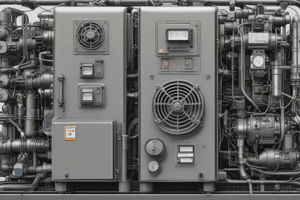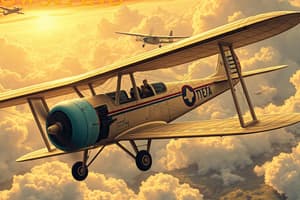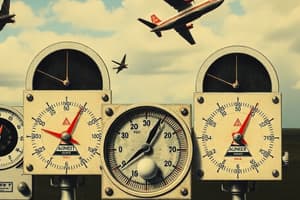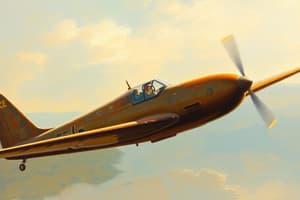Podcast
Questions and Answers
What is the cruise distance during flight planning?
What is the cruise distance during flight planning?
- The speed of the aircraft relative to the ground.
- The time spent flying at a constant altitude and speed.
- The indicated airspeed on the aircraft's airspeed indicator.
- The distance traveled during the cruise phase of flight. (correct)
Which altitude is affected by the altimeter setting?
Which altitude is affected by the altimeter setting?
- Minimum Elevation Figure
- Pressure Altitude (correct)
- Maximum Elevation Figure
- Cruise Altitude
What do VFR flight rules require from the pilot?
What do VFR flight rules require from the pilot?
- Navigating by visual reference to the ground. (correct)
- Navigating solely by instrument readings.
- Maintaining a constant power setting throughout the flight.
- Flying with a specified pressure altitude.
What is the function of Calibrated Airspeed (CAS)?
What is the function of Calibrated Airspeed (CAS)?
What does the term 'climb fuel' refer to in flight planning?
What does the term 'climb fuel' refer to in flight planning?
Which of the following is necessary to determine pressure altitude?
Which of the following is necessary to determine pressure altitude?
What does the term 'cruise altitude' signify in flight planning?
What does the term 'cruise altitude' signify in flight planning?
Which of the following accurately describes Compass Deviation?
Which of the following accurately describes Compass Deviation?
What is the lapse rate used for calculating outside air temperature (OAT) per 1,000 feet?
What is the lapse rate used for calculating outside air temperature (OAT) per 1,000 feet?
If the pressure altitude is 45,100 feet, what is the outside air temperature (OAT) if the ISA temperature is plus 6°C?
If the pressure altitude is 45,100 feet, what is the outside air temperature (OAT) if the ISA temperature is plus 6°C?
How is true air speed calculated according to the provided chart?
How is true air speed calculated according to the provided chart?
What is the formula for calculating fuel burn?
What is the formula for calculating fuel burn?
If the true air speed is 86 kts and the power setting is 22,100, what would be the fuel burn?
If the true air speed is 86 kts and the power setting is 22,100, what would be the fuel burn?
What percentage increase should be applied if the temperature is 20°C above standard?
What percentage increase should be applied if the temperature is 20°C above standard?
What does the climb performance chart display?
What does the climb performance chart display?
What must be corrected if the temperature is below standard?
What must be corrected if the temperature is below standard?
What factors should be considered when planning a flight?
What factors should be considered when planning a flight?
How do you calculate total time for a flight including both climb and cruise phases?
How do you calculate total time for a flight including both climb and cruise phases?
What information is crucial for calculating cruise distance?
What information is crucial for calculating cruise distance?
What does NOTAM stand for?
What does NOTAM stand for?
What type of information is not typically included in a NOTAM format?
What type of information is not typically included in a NOTAM format?
Which is NOT a source of weather information for flight planning?
Which is NOT a source of weather information for flight planning?
What is the true airspeed of an aircraft?
What is the true airspeed of an aircraft?
What is the primary difference between a rum line and a great circle?
What is the primary difference between a rum line and a great circle?
Which of the following is NOT a key item required for the flight planning form?
Which of the following is NOT a key item required for the flight planning form?
Why is it important to check NOTAMs before flight planning?
Why is it important to check NOTAMs before flight planning?
What should you do to access upper winds and temperature data for flight planning?
What should you do to access upper winds and temperature data for flight planning?
When calculating the true track for a flight plan, why is magnetic variation important?
When calculating the true track for a flight plan, why is magnetic variation important?
What is the significance of including cruising speed in the flight planning form?
What is the significance of including cruising speed in the flight planning form?
Flashcards
Cruise Time
Cruise Time
The time spent flying at a constant altitude and speed.
Cruise Distance
Cruise Distance
The distance traveled during the cruise phase of flight.
Power Setting
Power Setting
The RPM of the engine.
True Airspeed
True Airspeed
Signup and view all the flashcards
Calibrated Airspeed
Calibrated Airspeed
Signup and view all the flashcards
Ground Speed
Ground Speed
Signup and view all the flashcards
VFR (Visual Flight Rules)
VFR (Visual Flight Rules)
Signup and view all the flashcards
IFR (Instrument Flight Rules)
IFR (Instrument Flight Rules)
Signup and view all the flashcards
Outside Air Temperature (OAT)
Outside Air Temperature (OAT)
Signup and view all the flashcards
True Air Speed Interpolation Chart
True Air Speed Interpolation Chart
Signup and view all the flashcards
Interpolating True Air Speed
Interpolating True Air Speed
Signup and view all the flashcards
Lapse Rate
Lapse Rate
Signup and view all the flashcards
Fuel Burn Calculation
Fuel Burn Calculation
Signup and view all the flashcards
Climb Performance Chart
Climb Performance Chart
Signup and view all the flashcards
Temperature Correction
Temperature Correction
Signup and view all the flashcards
International Standard Atmosphere (ISA) Temperature
International Standard Atmosphere (ISA) Temperature
Signup and view all the flashcards
Climb Performance
Climb Performance
Signup and view all the flashcards
Cruise Performance
Cruise Performance
Signup and view all the flashcards
NOTAM
NOTAM
Signup and view all the flashcards
NOTAM N
NOTAM N
Signup and view all the flashcards
NOTAM R
NOTAM R
Signup and view all the flashcards
NOTAM C
NOTAM C
Signup and view all the flashcards
NOTAM Letter 'A'
NOTAM Letter 'A'
Signup and view all the flashcards
NOTAM Letter 'B'
NOTAM Letter 'B'
Signup and view all the flashcards
NOTAM Letter 'C'
NOTAM Letter 'C'
Signup and view all the flashcards
NOTAM Letter 'D'
NOTAM Letter 'D'
Signup and view all the flashcards
NOTAM Letter 'E'
NOTAM Letter 'E'
Signup and view all the flashcards
Rum Line
Rum Line
Signup and view all the flashcards
Great Circle
Great Circle
Signup and view all the flashcards
Plotter
Plotter
Signup and view all the flashcards
Study Notes
Calculating True Air Speed and Fuel Burn
- True air speed (TAS) calculation involves interpolating values from a chart based on power setting and outside air temperature (OAT).
- OAT calculation uses the International Standard Atmosphere (ISA) temperature at sea level, a lapse rate of 7.7°C per 1000 feet, and the pressure altitude.
- For example, at a 45,100-foot pressure altitude with an ISA temperature of +6°C, the OAT would be -14°C.
- TAS is calculated by averaging two values from the chart corresponding to the power setting.
- Fuel burn is determined using the formula: Fuel Burn = (True air speed * Power setting) / 100.
- Example: At 86 kts TAS and a 22100 power setting, the fuel burn is 106 gallons per hour.
Climb Performance Chart
- The chart relates pressure altitude to time to climb, fuel burn, and distance.
- Example values for 1000 and 5000 feet pressure altitude:
- 1000 ft: 1.3 minutes to climb, 1.6 gallons fuel burn, and 8 nautical miles.
- 5000 ft: 7 minutes to climb, 2.44 gallons fuel burn, and 8 nautical miles.
- Temperature corrections (1% per degree of difference from standard) are necessary for accurate calculations.
Flight Planning
- Cruise distance calculation requires subtracting the climb distance from the total distance.
- A flight from Brantford to Timbuktu with a 100 NM total distance and a 50 NM climb distance results in a 150 NM cruise distance.
- NOTAMs (Notices to Air Missions) inform pilots of potential hazards or airspace changes.
- Different NOTAM types include: New (N), Replacing (R), Canceling (C).
- NOTAMs have a specific format with components like the issuing airport, start/end dates and times, daily schedule, and explanations.
Weather Information
- Upper winds and temperature information are vital for flight planning.
- Sources include the Nat Canada website for airport codes like CYTZ (Toronto) and CYQG (Windsor).
- Data includes METARs, TAFs, and weather forecasts.
- Flight Rules: VFR (Visual Flight Rules) and IFR (Instrument Flight Rules) guide navigation.
Flight Planning Form
- A flight planning form contains essential information with 37 items.
- Key information includes destination, distance, cruising speed, magnetic bearing, True airspeed, time to destination, flight rules, weight/balance, RPM, pressure altitude, cruise altitude, wind direction/speed, and fuel.
Route Planning
- Rum lines (straight lines on maps) and great circles (shortest distances on a sphere) are used in flight planning.
- A plotter can be used to illustrate the true track of the flight.
- Account for Magnetic Variation when calculating true track.
Essential Flight Information
- Flight information includes cruise time, cruise distance, power setting (RPM), True airspeed, calibrated airspeed (CAS), ground speed, and flight rules.
Altitude Planning
- Altitude Type includes minimum elevation, maximum elevation, cruise altitude, and pressure altitude.
- Pressure altitude (PA) is the altimeter reading, but is affected by altimeter setting.
Additional Flight Information
- Considerations for flight planning include compass deviation, outside air temperature, climb distance, climb fuel, and cruise fuel.
Flight Planning Example
- Departure airport: CYV
- Destination: Collingwood
- Cruise altitude: 45,100 feet
- Power setting: 24,100 RPM
- Departure temperature: +23°C
Studying That Suits You
Use AI to generate personalized quizzes and flashcards to suit your learning preferences.
Description
This quiz tests your understanding of true air speed (TAS) calculations and fuel burn formulas. You'll learn to apply concepts such as outside air temperature (OAT) and pressure altitude to determine flight metrics. Dive into climb performance charts and fuel efficiency calculations essential for aviation.




